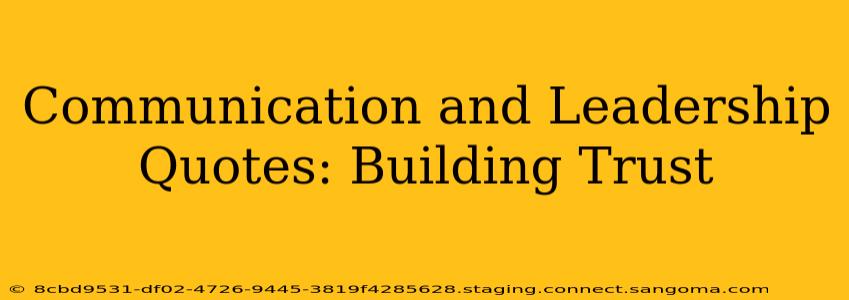Effective communication is the bedrock of strong leadership. More than just conveying information, it's about building trust, inspiring action, and fostering a collaborative environment. This article explores the power of communication in leadership, examining insightful quotes that highlight its crucial role in building trust and achieving organizational success. We'll delve into the nuances of effective communication, exploring how leaders can leverage words to create a positive and productive atmosphere.
Why are communication and leadership so closely linked?
The relationship between communication and leadership is symbiotic. Strong leaders are invariably strong communicators. They understand the power of their words to motivate, persuade, and inspire. Poor communication, conversely, erodes trust, creates confusion, and ultimately hinders progress. Think of it this way: a leader's message is their legacy; it's how they shape perceptions and drive actions within their team and organization.
What are some famous quotes about communication and leadership?
Many insightful thinkers have commented on the importance of communication in leadership. Here are a few impactful quotes that highlight this vital connection:
-
"The single biggest problem in communication is the illusion that it has taken place." – George Bernard Shaw: This quote highlights the critical need for confirmation and feedback. Simply delivering a message isn't enough; leaders must ensure their message is understood and received as intended. Active listening and seeking clarification are crucial components of this process.
-
"Leadership is influence, nothing more, nothing less." – Kenneth Blanchard: This underscores the power of communication in leadership. Influence is exerted through communication – it's the vehicle through which leaders shape perceptions, inspire action, and build consensus. A leader's ability to influence hinges on their communication skills.
-
"The key is not to prioritize what's on your schedule, but to schedule your priorities." – Stephen Covey: While seemingly unrelated to communication at first glance, this emphasizes the importance of clear communication in planning and execution. Leaders who effectively communicate their priorities ensure everyone is on the same page, maximizing efficiency and collaboration.
How does effective communication build trust?
Effective communication builds trust by:
-
Promoting transparency: Open and honest communication fosters trust. Leaders who openly share information, even difficult news, build credibility and demonstrate respect for their team.
-
Encouraging feedback: Creating a safe space for feedback shows that the leader values input and perspectives. This demonstrates respect and fosters a collaborative environment.
-
Active listening: Demonstrating genuine interest in what others have to say builds rapport and fosters trust. Active listening shows that the leader cares and values the contributions of their team.
-
Empathy and understanding: Leaders who show empathy and understanding build strong relationships based on mutual respect and trust.
-
Consistency in messaging: Consistent communication ensures that everyone is on the same page and minimizes confusion and distrust.
How can leaders improve their communication skills?
Improving communication skills is an ongoing process, but here are a few key strategies:
-
Practice active listening: Pay attention, ask clarifying questions, and summarize to ensure understanding.
-
Be clear and concise: Avoid jargon and ambiguity.
-
Seek feedback: Regularly solicit feedback from colleagues and team members.
-
Develop strong non-verbal communication skills: Body language and tone of voice significantly impact communication.
-
Use multiple communication channels: Tailor communication to the audience and the message.
What are some common communication barriers in leadership?
Several obstacles can hinder effective communication in leadership. These include:
-
Lack of clarity: Vague or ambiguous messages lead to confusion and misunderstandings.
-
Poor listening skills: Failure to actively listen prevents leaders from understanding their team's needs and concerns.
-
Information overload: Too much information can overwhelm people and make it difficult to focus on key messages.
-
Cultural differences: Differences in communication styles can create barriers to understanding.
-
Fear of conflict: Avoiding difficult conversations can lead to resentment and distrust.
Conclusion: The Indelible Mark of Communication in Leadership
In the tapestry of successful leadership, effective communication is the golden thread that binds everything together. It’s the catalyst for trust, the foundation for collaboration, and the engine for achieving organizational goals. By mastering the art of communication, leaders can unlock their full potential and inspire those around them to achieve greatness. The quotes above serve as powerful reminders of the enduring importance of clear, honest, and empathetic communication in building strong, trusted leadership.

